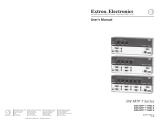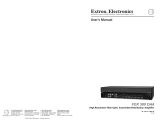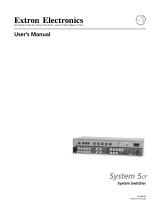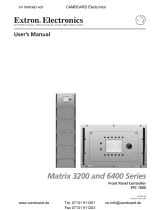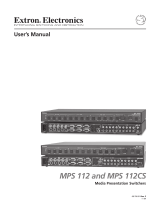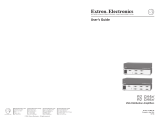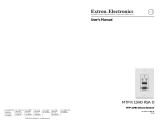Page is loading ...

MVX Plus 128 VGA A
Computer video (VGA) and Audio Matrix Switcher
68-521-30 Rev. B
04 07

This symbol is intended to alert the user of important operating and maintenance
(servicing) instructions in the literature provided with the equipment.
This symbol is intended to alert the user of the presence of uninsulated dangerous
voltage within the product’s enclosure that may present a risk of electric shock.
Caution
Read Instructions • Read and understand all safety and operating instructions before using the equipment.
Retain Instructions • The safety instructions should be kept for future reference.
Follow Warnings • Follow all warnings and instructions marked on the equipment or in the user
information.
Avoid Attachments • Do not use tools or attachments that are not recommended by the equipment
manufacturer because they may be hazardous.
Warning
Power sources • This equipment should be operated only from the power source indicated on the product. This
equipment is intended to be used with a main power system with a grounded (neutral) conductor. The
third (grounding) pin is a safety feature, do not attempt to bypass or disable it.
Power disconnection • To remove power from the equipment safely, remove all power cords from the rear of
the equipment, or the desktop power module (if detachable), or from the power source receptacle (wall
plug).
Power cord protection • Power cords should be routed so that they are not likely to be stepped on or pinched by
items placed upon or against them.
Servicing • Refer all servicing to qualifi ed service personnel. There are no user-serviceable parts inside. To
prevent the risk of shock, do not attempt to service this equipment yourself because opening or removing
covers may expose you to dangerous voltage or other hazards.
Slots and openings • If the equipment has slots or holes in the enclosure, these are provided to prevent
overheating of sensitive components inside. These openings must never be blocked by other objects.
Lithium battery • There is a danger of explosion if battery is incorrectly replaced. Replace it only with the
same or equivalent type recommended by the manufacturer. Dispose of used batteries according to the
manufacturer’s instructions.
Ce symbole sert à avertir l’utilisateur que la documentation fournie avec le matériel
contient des instructions importantes concernant l’exploitation et la maintenance
(réparation).
Ce symbole sert à avertir l’utilisateur de la présence dans le boîtier de l’appareil
de tensions dangereuses non isolées posant des risques d’électrocution.
Attention
Lire les instructions• Prendre connaissance de toutes les consignes de sécurité et d’exploitation avant
d’utiliser le matériel.
Conserver les instructions• Ranger les consignes de sécurité afi n de pouvoir les consulter à l’avenir.
Respecter les avertissements • Observer tous les avertissements et consignes marqués sur le matériel ou
présentés dans la documentation utilisateur.
Eviter les pièces de fi xation • Ne pas utiliser de pièces de fi xation ni d’outils non recommandés par le
fabricant du matériel car cela risquerait de poser certains dangers.
Avertissement
Alimentations• Ne faire fonctionner ce matériel qu’avec la source d’alimentation indiquée sur l’appareil. Ce
matériel doit être utilisé avec une alimentation principale comportant un fi l de terre (neutre). Le troisième
contact (de mise à la terre) constitue un dispositif de sécurité : n’essayez pas de la contourner ni de la
désactiver.
Déconnexion de l’alimentation• Pour mettre le matériel hors tension sans danger, déconnectez tous les cordons
d’alimentation de l’arrière de l’appareil ou du module d’alimentation de bureau (s’il est amovible) ou
encore de la prise secteur.
Protection du cordon d’alimentation • Acheminer les cordons d’alimentation de manière à ce que personne ne
risque de marcher dessus et à ce qu’ils ne soient pas écrasés ou pincés par des objets.
Réparation-maintenance • Faire exécuter toutes les interventions de réparation-maintenance par un technicien
qualifi é. Aucun des éléments internes ne peut être réparé par l’utilisateur. Afi n d’éviter tout danger
d’électrocution, l’utilisateur ne doit pas essayer de procéder lui-même à ces opérations car l’ouverture ou le
retrait des couvercles risquent de l’exposer à de hautes tensions et autres dangers.
Fentes et orifi ces • Si le boîtier de l’appareil comporte des fentes ou des orifi ces, ceux-ci servent à empêcher
les composants internes sensibles de surchauffer. Ces ouvertures ne doivent jamais être bloquées par des
objets.
Lithium Batterie • Il a danger d’explosion s’ll y a remplacment incorrect de la batterie. Remplacer uniquement
avec une batterie du meme type ou d’un ype equivalent recommande par le constructeur. Mettre au reut les
batteries usagees conformement aux instructions du fabricant.
Safety Instructions • English
Consignes de Sécurité • Français
Sicherheitsanleitungen • Deutsch
Dieses Symbol soll dem Benutzer in der im Lieferumfang enthaltenen
Dokumentation besonders wichtige Hinweise zur Bedienung und Wartung
(Instandhaltung) geben.
Dieses Symbol soll den Benutzer darauf aufmerksam machen, daß im Inneren des
Gehäuses dieses Produktes gefährliche Spannungen, die nicht isoliert sind und
die einen elektrischen Schock verursachen können, herrschen.
Achtung
Lesen der Anleitungen • Bevor Sie das Gerät zum ersten Mal verwenden, sollten Sie alle Sicherheits-und
Bedienungsanleitungen genau durchlesen und verstehen.
Aufbewahren der Anleitungen • Die Hinweise zur elektrischen Sicherheit des Produktes sollten Sie
aufbewahren, damit Sie im Bedarfsfall darauf zurückgreifen können.
Befolgen der Warnhinweise • Befolgen Sie alle Warnhinweise und Anleitungen auf dem Gerät oder in der
Benutzerdokumentation.
Keine Zusatzgeräte • Verwenden Sie keine Werkzeuge oder Zusatzgeräte, die nicht ausdrücklich vom
Hersteller empfohlen wurden, da diese eine Gefahrenquelle darstellen können.
Vorsicht
Stromquellen • Dieses Gerät sollte nur über die auf dem Produkt angegebene Stromquelle betrieben werden.
Dieses Gerät wurde für eine Verwendung mit einer Hauptstromleitung mit einem geerdeten (neutralen)
Leiter konzipiert. Der dritte Kontakt ist für einen Erdanschluß, und stellt eine Sicherheitsfunktion dar. Diese
sollte nicht umgangen oder außer Betrieb gesetzt werden.
Stromunterbrechung • Um das Gerät auf sichere Weise vom Netz zu trennen, sollten Sie alle Netzkabel
aus der Rückseite des Gerätes, aus der externen Stomversorgung (falls dies möglich ist) oder aus der
Wandsteckdose ziehen.
Schutz des Netzkabels • Netzkabel sollten stets so verlegt werden, daß sie nicht im Weg liegen und niemand
darauf treten kann oder Objekte darauf- oder unmittelbar dagegengestellt werden können.
Wartung • Alle Wartungsmaßnahmen sollten nur von qualifi ziertem Servicepersonal durchgeführt werden.
Die internen Komponenten des Gerätes sind wartungsfrei. Zur Vermeidung eines elektrischen Schocks
versuchen Sie in keinem Fall, dieses Gerät selbst öffnen, da beim Entfernen der Abdeckungen die Gefahr
eines elektrischen Schlags und/oder andere Gefahren bestehen.
Schlitze und Öffnungen • Wenn das Gerät Schlitze oder Löcher im Gehäuse aufweist, dienen diese zur
Vermeidung einer Überhitzung der empfi ndlichen Teile im Inneren. Diese Öffnungen dürfen niemals von
anderen Objekten blockiert werden.
Litium-Batterie • Explosionsgefahr, falls die Batterie nicht richtig ersetzt wird. Ersetzen Sie verbrauchte
Batterien nur durch den gleichen oder einen vergleichbaren Batterietyp, der auch vom Hersteller
empfohlen wird. Entsorgen Sie verbrauchte Batterien bitte gemäß den Herstelleranweisungen.
Este símbolo se utiliza para advertir al usuario sobre instrucciones importantes
de operación y mantenimiento (o cambio de partes) que se desean destacar en el
contenido de la documentación suministrada con los equipos.
Este símbolo se utiliza para advertir al usuario sobre la presencia de elementos con
voltaje peligroso sin protección aislante, que puedan encontrarse dentro de la caja
o alojamiento del producto, y que puedan representar riesgo de electrocución.
Precaucion
Leer las instrucciones • Leer y analizar todas las instrucciones de operación y seguridad, antes de usar el
equipo.
Conservar las instrucciones • Conservar las instrucciones de seguridad para futura consulta.
Obedecer las advertencias • Todas las advertencias e instrucciones marcadas en el equipo o en la
documentación del usuario, deben ser obedecidas.
Evitar el uso de accesorios • No usar herramientas o accesorios que no sean especifi camente recomendados
por el fabricante, ya que podrian implicar riesgos.
Advertencia
Alimentación eléctrica • Este equipo debe conectarse únicamente a la fuente/tipo de alimentación eléctrica
indicada en el mismo. La alimentación eléctrica de este equipo debe provenir de un sistema de distribución
general con conductor neutro a tierra. La tercera pata (puesta a tierra) es una medida de seguridad, no
puentearia ni eliminaria.
Desconexión de alimentación eléctrica • Para desconectar con seguridad la acometida de alimentación eléctrica
al equipo, desenchufar todos los cables de alimentación en el panel trasero del equipo, o desenchufar el
módulo de alimentación (si fuera independiente), o desenchufar el cable del receptáculo de la pared.
Protección del cables de alimentación • Los cables de alimentación eléctrica se deben instalar en lugares donde
no sean pisados ni apretados por objetos que se puedan apoyar sobre ellos.
Reparaciones/mantenimiento • Solicitar siempre los servicios técnicos de personal califi cado. En el interior no
hay partes a las que el usuario deba acceder. Para evitar riesgo de electrocución, no intentar personalmente
la reparación/mantenimiento de este equipo, ya que al abrir o extraer las tapas puede quedar expuesto a
voltajes peligrosos u otros riesgos.
Ranuras y aberturas • Si el equipo posee ranuras o orifi cios en su caja/alojamiento, es para evitar el
sobrecalientamiento de componentes internos sensibles. Estas aberturas nunca se deben obstruir con otros
objetos.
Batería de litio • Existe riesgo de explosión si esta batería se coloca en la posición incorrecta. Cambiar esta
batería únicamente con el mismo tipo (o su equivalente) recomendado por el fabricante. Desachar las
baterías usadas siguiendo las instrucciones del fabricante.
Instrucciones de seguridad • Español
Precautions
ᅝܼ乏ⶹ•Ё᭛
䖭Ͼヺোᦤ⼎⫼᠋䆹䆒⫼᠋ݠЁ᳝䞡㽕ⱘ᪡㓈ᡸ䇈ᯢDŽ
䖭Ͼヺো䄺ਞ⫼᠋䆹䆒ᴎݙ᳝ᲈ䴆ⱘॅ䰽⬉य़ˈ᳝㾺⬉ॅ䰽DŽ
⊼ᛣ
䯙䇏䇈ᯢк• 䑩ㅸỀ䑩嬦嫿⡈⼆枼敆嬼䍇夤ㆁ㙊⫊₩⏍Ề䑩嬵㕏ɿ
ֱᄬ䇈ᯢк• 䑩ㅸⷕ⪙⫊₩嬵㕏ᶧḦ⡈⭇㚦Ề䑩ɿ
䙉ᅜ䄺ਞ• 䑩ㅸⷕ徶⫉ᷨ␂⏍䑩ㅸ㉈⊘ᵋ䗅ㆁ㙊⫊₩⏍㐎ẝ嬵㕏ɿ
䙓ܡ䗑ࡴ• ᵎ壂Ề䑩嬦ᷨ␂⋃⒇㯢㙊㋩劑䗅₸ㅗ弾⇡嫿⡈澤Ḧ忀₎⊲斪ɿ
䄺ਞ
⬉⑤• 嬦嫿⡈⌫倾Ề䑩ᷨ␂ᵋ㝈㕏䗅䑶㷑ɿ嫿⡈⼆枼Ề䑩㙊♱一䗅Ờ䑶䰼丠Ờ䑶ɿ䩭ᵊ㚢一
澠♱一澡㕰⫊₩嫿㓾澤ᵎ倾ᵎ䑩ㅗ崴弈ɿ
ᢨᥝ⬉⑤• ᵻ⫊₩♱ḏ嫿⡈㈕㋊䑶㷑澤嬸㈕㋊ㆁ㙊嫿⡈⍏ㅗ㞍暣䑶㷑䗅䑶㷑一澤ㅗḼẖ㋦ⅱⵃ
䑶䰼丠䗅䑶㷑一ɿ
⬉⑤㒓ֱᡸ• ⣦Ⓟⵄ一澤忀₎埬嵪嵐澤ㅗ愎䆪㉥⋌ɿ
㓈ᡸ•ㆁ㙊丵Ἧ⼆枼䑲嫥嬂䗅丵Ἧ᷻⎙弜垍ɿ嫿⡈怩㯢㙊䑩ㅸ⌰Ḧ㘵㊣䗅昷ḷɿᵻ忀₎℻
䋱大䑶⊲斪ᵎ壂儫ⴲ嬖☿㆔⹁嫿⡈䘗⪑丵Ἧ嬦嫿⡈ɿ
䗮亢ᄨ• 㙊ᷜ嫿⡈㙻⠴ᵋ㙊彛栏㤾ㅗ⪕澤⫄ḭ㕰䑩㚦敳㪣㙻㒐だ₄ḷ弈䀮ɿᵎ壂䑩Ḽẖᵝ
壀㉢Ẑ彛栏⪕ɿ
䫖⬉∴• ᵎ㪤䞯䗅㘵㊣䑶㮡ṛ㙊䅇㿹䗅⊲斪ɿ⼆枼Ề䑩ᵏ⋃⫷㋩劑䗅䘹⍍ㅗ䘹弒⛌⌸䗅䑶㮡ɿ
㉊䂨䑠ᷨ⋃䗅⸻嫯⡅䍇ⷠ⹄䑶㮡ɿ

FCC Class A Notice
N
This equipment has been tested and found to comply with the limits for a
Class A digital device, pursuant to part 15 of the FCC Rules. These limits are
designed to provide reasonable protection against harmful interference when
the equipment is operated in a commercial environment. This equipment
generates, uses and can radiate radio frequency energy and, if not installed
and used in accordance with the instruction manual, may cause harmful
interference to radio communications. Operation of this equipment in a
residential area is likely to cause harmful interference, in which case the
user will be required to correct the interference at his own expense.
N
This unit was tested with shielded cables on the peripheral devices. Shielded
cables must be used with the unit to ensure compliance.
This device complies with Part 15 of the FCC Rules. Operation is subject
to the following two conditions: (1) this device may not cause harmful
interference, and (2) this device must accept any interference received,
including interference that may cause undesired operation


QS-1
MVX Plus 128 VGA A Matrix Switcher • Quick Start
PRELIMINARY
Installation
Step 1
Turn off power to the input and output devices,
and disconnect the power cords.
Step 2 — Inputs
a. Connect up to 12 high resolution
video inputs to the 15-pin HD
input connectors.
b. Connect up to 12 stereo or mono audio
inputs to the 5-pin captive screw connectors.
Step 3 — Outputs
a. Connect up to 8 high resolution
video devices to the 15-pin HD
output connectors.
b. Connect up to 8 balanced or unbalanced
stereo audio or mono audio devices to the
5-pin captive screw connectors.
Step 4 — RS-232/RS-422
If desired, connect a control system or computer
to the Remote RS-232/RS-422 port.
Step 5
If desired, connect a control system or computer
to the front panel Configuration (RS-232) port.
Use an optional 9-pin D to 2.5 mm mini jack
TRS RS-232 cable, part #70-335-01.
Step 6 — Ethernet
If desired, connect a network WAN or
LAN hub, a control system, or computer
to the Ethernet RJ-45 port. See chapter 2,
“Installation”, for details.
• Network connection — Wire as a patch
(straight) cable.
• Computer or control system connection —
Wire the interface cable as a crossover cable.
Step 7 — Power
Plug the switcher into a grounded AC source.
Definitions
Tie — An input-to-output connection
Set of ties — An input tied to 2 or more outputs
Configuration — One or more ties or sets of ties
Current configuration — The currently active
configuration (also called configuration 0)
Global preset — A configuration that has been
stored. One global preset can be assigned
to each input button. When a global preset
is retrieved from memory, it becomes the
current configuration.
Front Panel Controls
Input and output buttons select inputs and
outputs. Output buttons light amber to
indicate video and audio ties. The buttons
light green to indicate video-only ties. The
buttons light red to indicate audio-only ties.
Input and output buttons also select presets.
The output buttons also display the selected
input’s audio level.
The input buttons also display the selected
output’s volume level.
Enter button saves changes.
Preset button saves a configuration as a preset or
recalls a previously-defined preset.
View button selects a view-only mode that
prevents inadvertent configuration changes.
On audio models, View decrements the level
and volume. See “Viewing and adjusting the
audio level” on page QS-2.
Quick Start — MVX Plus 128 VGA A Matrix Switcher
RS-232 Function Pin Function
1
2
3
4
5
6
7
8
9
—
TX
RX
—
Gnd
—
—
—
—
Not used
Transmit
Receive
Not used
Ground
Not used
Not used
Not used
Not used
—
TX–
RX–
—
Gnd
—
RX+
TX+
—
Not used
Transmit (–)
Receive (–)
Not used
Ground
Not used
Receive (+)
Transmit (+)
Not used
RS-422
5
1
9
6
L R
Unbalanced Input
Balanced Input
(high impedance)
(high impedance)
Ring
Sleeve (s)
Tip
Sleeve
Tip
Sleeve
Tip
Tip
Ring
CAUTION Connect the sleeve to ground.
Connecting the sleeve to a negative (-)
terminal will damage the audio output
circuits.
Unbalanced Output
Balanced Output
L R
Ring
Tip
Sleeve(s)
Tip
Ring
Sleeve(s)
Tip
Tip
NO GROUND HERE.
NO GROUND HERE.

MVX Plus 128 VGA A Matrix Switcher • Quick Start
QS-2
PRELIMINARY
Quick Start —
MVX Plus 128 VGA A Matrix Switcher, continued
Esc button cancels selections in progress and
resets the front panel button indications.
The Esc button does not reset the current
configuration, the RGBHV and audio
selection, any presets, or any audio level
or volume settings. On audio models,
Esc increments the level and volume. See
“Viewing and adjusting the audio level” in
the next column.
RGBHV and Audio buttons select/deselect
video and/or audio. The Audio button blinks
to indicate audio breakaway. The Audio
button also selects the audio level/adjust
mode. See “Viewing and adjusting the audio
level” in the next column.
Creating a tie
1. Press and release the RGBHV and/or Audio
I/O button(s) to select or deselect video and/
or audio as desired.
2. Press and release the desired input button.
3. Press and release the desired output button(s).
4. Press and release the Enter button.
I / O
RGBHV AUDIO
Green when selected.
Off when deselected.
Red when selected.
Off when deselected.
5
The button lights to indicate the selection.
3 4
ENTER
8
Amber indicates RGBHV/video and audio tie.
Green indicates RGBHV/video only tie.
Red indicates audio only tie.
Green indicates the need
to confirm the change.
PRESET
PRESET
PRESET
PRESET
Preset button blinks.
Press and hold.
2 seconds
Save a
preset
Recall a
preset
Preset button lights. Press and release.
All input and output buttons with
assigned presets light red.
The configuration data at assigned
preset locations will be overwritten.
INPUTS
1
2
3
4
5
6
7
1
ENTER
The button blinks red to indicate that
this preset is selected to save or recall.
The Enter button blinks
green to indicate the need
to activate the save or recall.
AUDIO
AUDIO
Audio button blinks. Press and
hold
2 seconds
1 2
5
Press an Input button to adjust gain/attenuation.
Press an Output button to adjust volume.
Output buttons display gain/attenuation.
Input buttons display volume.
ESCVIEW
button decreases
the level or volume.
button increases
the level or volume.
Saving or recalling a preset
1. Save a preset — Press and hold the Preset
button for 2 seconds.
Recall a preset — Press and release the Preset
button.
2. Press and release the desired input or output
button.
3. Press and release the Enter button.
Viewing and adjusting the audio level
1. Press and hold the Audio button.
2.
Press an input or output button. See chapter 3,
“Operation” to read the displayed value.
3. Increase and decrease the gain/attenuation
or volume level by pressing the Esc (
>
) and
View (
<
) buttons.
4. Press and release the Audio button to exit.

i
MVX Plus 128 VGA A Matrix Switcher • Table of Contents
PRELIMINARY
Table of Contents
Chapter One • Introduction ......................................................................................................1-1
About this Manual .....................................................................................................................1-2
About the MVX Plus 128 VGA A Matrix Switcher ..................................................1-2
Definitions ......................................................................................................................................1-3
Features ............................................................................................................................................1-4
Chapter Two • Installation ..........................................................................................................2-1
Mounting the Switcher .......................................................................................................... 2-2
UL requirements ..................................................................................................................2-2
Mounting instructions .........................................................................................................2-2
Rear Panel Cabling and Views............................................................................................2-3
Video connections .....................................................................................................................2-3
Audio connections ....................................................................................................................2-4
RS-232/RS-422 connection ........................................................................................................2-5
Ethernet connection .................................................................................................................2-6
Cabling and RJ-45 connector wiring ..................................................................................2-6
Reset button ..............................................................................................................................2-7
Power connection ....................................................................................................................2-7
Front Panel Configuration Port .........................................................................................2-8
Chapter Three • Operation ........................................................................................................3-1
Front Panel Controls and Indicators ............................................................................... 3-2
Definitions .................................................................................................................................. 3-2
Input and output buttons ........................................................................................................3-3
Control buttons ......................................................................................................................... 3-4
I/O controls .................................................................................................................................3-7
Button icons ...............................................................................................................................3-8
Front Panel Operations ...........................................................................................................3-8
Front panel security lockouts ..................................................................................................3-8
Power .......................................................................................................................................... 3-8
Creating a configuration .........................................................................................................3-9
Example 1: Creating a set of video and audio ties .......................................................... 3-10
Example 2: Adding a tie to a set of video and audio ties ...............................................3-12
Example 3: Removing a tie from a set of video and audio ties ......................................3-14
Viewing a configuration ........................................................................................................3-16
Example 4: Viewing video and audio, audio only, and video only ties ..........................3-17
I/O grouping.............................................................................................................................3-19
Example 5: Grouping inputs and outputs ........................................................................3-21
Setting RGB delay ...................................................................................................................3-23
Example 6: Setting the RGB delay for an output ............................................................3-24
Using presets ............................................................................................................................ 3-26
Example 7: Saving a preset ...............................................................................................3-27
Example 8: Recalling a preset ...........................................................................................3-28
Muting and unmuting video and/or audio outputs ..........................................................3-29
Example 9: Muting and unmuting an output..................................................................3-29

Table of Contents, cont’d
MVX Plus 128 VGA A Matrix Switcher • Table of Contents
ii
PRELIMINARY
Viewing and adjusting the input audio level .....................................................................3-32
Example 10: Viewing and adjusting an input audio level ..............................................3-34
Viewing and adjusting the output volume .........................................................................3-36
Reading the displayed volume .........................................................................................3-37
Example 11: Viewing and adjusting an output volume level .........................................3-39
Setting the front panel locks (Executive modes) ................................................................3-41
Selecting Lock mode 2 or toggling between mode 2 and mode 0 ................................ 3-41
Selecting Lock mode 2 or toggling between mode 2 and mode 1 ................................ 3-42
Performing a system reset from the front panel................................................................3-42
Background illumination .......................................................................................................3-43
Selecting the rear panel Remote port protocol and baud rate ....................................... 3-43
Rear Panel Operations ...........................................................................................................3-44
Performing soft system resets ...............................................................................................3-45
Performing a hard reset .........................................................................................................3-46
Optimizing the Audio ............................................................................................................ 3-47
Troubleshooting ........................................................................................................................3-47
Configuration Worksheets .................................................................................................3-48
Worksheet example 1: System equipment .......................................................................... 3-48
Worksheet example 2: Daily configuration.........................................................................3-49
Worksheet example 3: Test configuration ..........................................................................3-50
Configuration worksheet .......................................................................................................3-51
Chapter Four • Programmer’s Guide .................................................................................. 4-1
Serial Ports ..................................................................................................................................... 4-2
Rear panel Remote port ...........................................................................................................4-2
Front panel Configuration port ..............................................................................................4-3
Ethernet Link ................................................................................................................................4-4
Ethernet connection .................................................................................................................4-4
Default IP addresses ..................................................................................................................4-4
Host-to-Switcher Instructions .............................................................................................4-5
Switcher-Initiated Messages ...............................................................................................4-5
Switcher Error Responses ..................................................................................................... 4-6
Using the Command/Response Tables ...........................................................................4-6
Command/Response Table for SIS
™
Commands ...................................................... 4-7
Symbol definitions ....................................................................................................................4-7
Command/response table for SIS commands ........................................................................4-8
Command/Response Table for IP SIS Commands .................................................4-17
Symbol definitions ..................................................................................................................4-17
Command/response table for IP SIS commands ..................................................................4-18
Special Characters ...................................................................................................................4-19

iii
MVX Plus 128 VGA A Matrix Switcher • Table of Contents
PRELIMINARY
Chapter Five • Matrix Software ............................................................................................. 5-1
Matrix Switchers Control Program .................................................................................5-2
Installing the software .............................................................................................................5-2
Software operation via Ethernet ............................................................................................ 5-3
Ethernet protocol settings ..................................................................................................5-3
Using the Matrix Switcher Control software ........................................................................5-4
IP Settings/Options window ....................................................................................................5-6
Matrix IP Address field ........................................................................................................5-7
Extron Name/Descriptor field .............................................................................................5-8
Gateway IP address field ..................................................................................................... 5-8
Subnet Mask field ................................................................................................................5-8
Hardware Address field.......................................................................................................5-8
Use DHCP checkbox ............................................................................................................. 5-9
Date field .............................................................................................................................5-9
Time (local) field ..................................................................................................................5-9
Sync Time to PC button .......................................................................................................5-9
GMT (offset) field ................................................................................................................5-9
Use Daylight Savings checkbox .........................................................................................5-10
Administrator Password field ...........................................................................................5-10
User Password field ...........................................................................................................5-10
Mail Server IP Address field ..............................................................................................5-11
Mail Server Domain Name field........................................................................................5-11
E-mail Addressee fields .....................................................................................................5-12
Updating firmware ................................................................................................................. 5-13
Ethernet-connected firmware upload ..............................................................................5-14
Serial-port-connected firmware upload ...........................................................................5-15
Uploading HTML files .............................................................................................................5-17
Windows buttons, drop boxes, and trashcan .....................................................................5-18
Windows menus ......................................................................................................................5-18
File menu ...........................................................................................................................5-18
Tools menu .........................................................................................................................5-19
Preferences menu .............................................................................................................. 5-20
Master-Reset selection .......................................................................................................5-22
Using Emulation mode .........................................................................................................5-22
Using the help system ............................................................................................................5-22
Special Characters ...................................................................................................................5-22
Button-Label Generator Program ..................................................................................5-23
Using the Button-Label Generator software ......................................................................5-24

Table of Contents, cont’d
MVX Plus 128 VGA A Matrix Switcher • Table of Contents
iv
PRELIMINARY
Chapter 6 • HTML Operation ...................................................................................................5-25
Download the Startup Page ................................................................................................6-2
System Status Page ..................................................................................................................6-3
DSVP page ..................................................................................................................................6-4
System Configuration Page .................................................................................................6-5
IP Settings fields ........................................................................................................................6-6
Unit Name field ...................................................................................................................6-6
DHCP radio buttons .............................................................................................................6-6
IP Address field ....................................................................................................................6-6
Gateway IP Address field ....................................................................................................6-6
Subnet Mask field ................................................................................................................6-6
MAC Address field ............................................................................................................... 6-6
Firmware field .....................................................................................................................6-6
Model field ..........................................................................................................................6-6
Part Number field ................................................................................................................ 6-7
Date/Time Settings fields .........................................................................................................6-7
Passwords page .........................................................................................................................6-8
Email Settings page .................................................................................................................. 6-9
Mail IP Address field ............................................................................................................6-9
Domain Name field .............................................................................................................6-9
Email address fields ...........................................................................................................6-10
Firmware Upgrade page ........................................................................................................6-10
File Management Page .........................................................................................................6-11
Set and View Ties Page .........................................................................................................6-12
Creating a tie ........................................................................................................................... 6-13
RGB and Audio Settings page ...............................................................................................6-13
Changing the input gain and attenuation ......................................................................6-14
Muting and unmuting one or all outputs........................................................................6-15
Changing the RGB delay ...................................................................................................6-16
Changing the output volume level ..................................................................................6-17
Global Presets page ................................................................................................................ 6-19
Saving a preset ..................................................................................................................6-19
Recalling a preset ..............................................................................................................6-19
Special Characters ...................................................................................................................6-20

v
MVX Plus 128 VGA A Matrix Switcher • Table of Contents
PRELIMINARY
Appendix A • Ethernet Connection .................................................................................... A-1
Ethernet Link ............................................................................................................................... A-2
Ethernet connection ................................................................................................................ A-2
Default address ........................................................................................................................ A-2
Pinging to determine Extron IP address............................................................................ A-3
Pinging to determine Web IP address ............................................................................... A-3
Connecting as a Telnet client ................................................................................................. A-4
Telnet tips ............................................................................................................................ A-4
Open .............................................................................................................................. A-4
Escape character and Esc key ....................................................................................... A-5
Local echo ...................................................................................................................... A-5
Set carriage return-line feed ........................................................................................ A-5
Close .............................................................................................................................. A-5
Help ............................................................................................................................... A-5
Quit ................................................................................................................................ A-5
Subnetting — A Primer .......................................................................................................... A-6
Gateways ................................................................................................................................... A-6
Local and remote devices ........................................................................................................ A-6
IP addresses and octets ............................................................................................................ A-6
Subnet masks and octets ......................................................................................................... A-6
Determining whether devices are on the same subnet ..................................................... A-7
Appendix B • Specifications, Part Numbers, Accessories ..................................B-1
Specifications ...............................................................................................................................B-2
Part Numbers and Accessories ...........................................................................................B-5
Included parts ............................................................................................................................B-5
Accessories .................................................................................................................................B-5
Cables ..........................................................................................................................................B-6
Button Labels ................................................................................................................................B-7
Installing labels in the matrix switcher’s buttons .................................................................B-7
Button label blanks ...................................................................................................................B-9

Table of Contents, cont’d
MVX Plus 128 VGA A Matrix Switcher • Table of Contents
vi
PRELIMINARY
68-521-30 B
04 07
All trademarks mentioned in this manual are the properties of their respective owners.

PRELIMINARY
MVX Plus 128 VGA A Matrix Switcher
1
Chapter One
Introduction
About this Manual
About the MVX Plus 128 VGA A Matrix Switcher
Definitions
Features

MVX Plus 128 VGA A Matrix Switcher • Introduction
1-2
Introduction
PRELIMINARY
About this Manual
This manual contains installation, configuration, and operating information for
the Extron MVX Plus 128 VGA A 12-input by 8-output wideband computer video
(VGA) and audio (A) matrix switcher.
About the MVX Plus 128 VGA A Matrix Switcher
The MVX matrix switcher distributes any of 12 inputs to any combination of
8 outputs. The matrix switcher can route multiple input/output configurations
simultaneously.
The matrix switcher is a single box solution to complex wideband video and/or
audio routing applications (figure 1-1). Each input and output is individually
isolated and buffered, and any input(s) can be switched to any one or all outputs
with virtually no crosstalk or signal noise between channels.
I
N
P
U
T
S
O
U
T
P
U
T
S
RE
S
ET
RS232/RS422
REMOTE
L
I
S
T
E
D
1
T
2
3
I
.
T
.
E
.
C
U
S
1
2
3
4
5
6 7
8
9 1
0
1
1
1
2
LAN
1 2
3
4
5
6 7
8
1
2
3
4
5
6
7
8
9
1
0
1
1
1
2
1
2
3
4
5
6
7
8
I
N
P
U
T
S
O
U
T
P
U
T
S
Control System
Plasma
Plasma
LCD
Projector
V
S
C
5
0
0
S
C
A
N
C
O
N
V
E
R
T
E
R
S
IZ
E
M
IN
/M
A
X
NE
X
T
M
E
N
U
F
RE
E
Z
E
RE
S
E
T
IR
C
EN
T
ER
/P
A
N
/S
IZ
E
Sound System
Extron
VSC 500
Video Scan Converter
VCR
PC
Laptop
Laptop
Audio In
DVD
Extron
MVX Series
VGA & Audio
Matrix Switcher
Audio In
Audio Out
LAN
Ethernet
V
I
D
5
0
/
6
0
H
z
1
2
3
4
Y
/V
I
D
B
-
Y
H
/
H
V
R
/R
-
Y
V
G
/Y
B
/
B
-
Y
R
S
-
2
3
2
L
A
N
R
E
S
E
T
A
C
T
L
I
N
K
R
G
B
/
R
-
Y
,
Y
,B
-
Y
Y
C
S
D
I
R
-
Y
/
C
R
G
B
/
R
-
Y
,
Y
,B
-
Y
/
Y
C
/
V
I
D
1
0
0
-
2
4
0
V
.
3
A
I
N
P
U
T
O
U
T
P
U
T
I
N
P
U
T
O
U
T
P
U
T
Extron
DVS 304
Digital Video Scaler
Figure 1-1 — Typical MVX Plus 128 VGA A matrix switcher application

1-3
MVX Plus 128 VGA A Matrix Switcher • Introduction
PRELIMINARY
The MVX Plus 128 VGA A switcher inputs and outputs VGA video on 15-pin HD
connectors and audio on 3.5 mm, 5-pole captive screw terminals.
The audio switching can either be linked with the video (audio follow) or be
independent of the video (audio breakaway). Adjustable input audio gain and
attenuation compensates for level differences between audio inputs.
The matrix switcher can be remotely controlled via its LAN port, its rear panel
RS-232/RS-422 Remote port, and its front panel Configuration (RS-232) port using
either Extron’s Windows
®
-based Matrix Switchers Control Program or the Simple
Instruction Set (SIS
™
). The SIS is a set of basic ASCII code commands that provide
simple control through a control system or PC without programming long, obscure
strings of code. SIS commands can be entered via either the Ethernet link or the
RS-232/RS-422 link.
The LAN port can be connected through a local area network (LAN) or wide area
network (WAN).
The MVX Plus 128 VGA A features e-mail notification of maintenance or other
details concerning the status of the power supplies and the loss or resumption of
sync on individual inputs to concerned personnel.
The LAN port and both serial ports can be connected to and operated from:
• A control system
• A PC
• An Extron MKP 2000 remote control panel
• An Extron MKP 3000 remote control panel
• An Extron MCP 1000 remote control panel and/or MKP 1000 remote keypad
The matrix switcher is housed in a rack-mountable, 2U high metal enclosure with
mounting flanges for a standard 19" rack. The appropriate rack mounting kit is
included with the switcher.
The switchers have an internal 100 VAC to 240 VAC, 50/60 Hz, 30 watts
autoswitchable power supply that provides worldwide power compatibility.
The MVX Plus 128 VGA A switcher has a minimum bandwidth of 300 MHz (-3 dB).
It can also switch RGBS, RGsB, RsGsBs, HDTV, component video, S-video, and
composite video.
Definitions
The following terms are used throughout this manual:
Tie — An input-to-output connection.
Set of ties — An input tied to two or more outputs. (An output can never be tied
to more than one input.)
Configuration — One or more ties or one or more sets of ties.
Current configuration — The configuration that is currently active in the
switcher (also called configuration 0)
Global memory preset — A configuration that has been stored. Up to 32 global
memory presets can be stored in memory. Preset locations are assigned
to the input buttons and output buttons. When a preset is retrieved from
memory, it becomes the current configuration.
The switcher has 32 presets. Up to 20 presets can be selected from the front
panel for either saving or retrieving. Preset numbers larger than 20 are
accessible via serial port or Ethernet control.

Introduction, cont’d
MVX Plus 128 VGA A Matrix Switcher • Introduction
1-4
PRELIMINARY
Features
Video — The switcher inputs and outputs RGBHV or RGBS (VGA) video on
15-pin HD connectors. It can also switch RGsB, RsGsBs, component/HDTV,
S-video, or composite video.
Bandwidth — The MVX Plus 128 VGA A switcher provides a minimum of
300 MHz (-3 dB) video bandwidth, fully loaded.
Audio inputs — Input and output stereo audio, balanced or unbalanced, is
provided on 3.5 mm, 5-pole captive screw terminals.
Audio input gain/attenuation — Individual input audio levels can be adjusted so
there are no noticeable volume differences between sources. You can set the
input level of audio gain or attenuation (-18 dB to +24 dB) via the Ethernet
link, either serial port, or the front panel.
Audio output volume — The audio volume of each output can be displayed and
adjusted through a range of full output to completely silent, from the front
panel or via serial port or Ethernet control.
Digital Sync Validation Processing (DSVP™) — In critical environments or
unmanned, remote locations, it may be vital to know that sources are active
and switching. Extron’s DSVP confirms that input sources are active by
scanning all sync inputs for active signals. DSVP provides instantaneous
frequency feedback for composite sync or separate horizontal and vertical
sync signals via the switchers’ serial port or LAN port. The frequency
information can be displayed on any control system or in a Windows
®
-based
control program on a local-area network (LAN) or Internet (IP) connection
(figure 1-2).
OR
Input Horz. Vert.
01 31.50 60.00
02 31.50 60.00
03 31.50 60.00
04 48.01 67.50
05 48.01 67.50
06 48.01 67.50
07 48.01 67.50
08 61.55 72.00
09 61.55 72.00
10 61.55 72.00
11 61.55 72.00
12 61.55 72.00
Sample control system panel
Windows-based control program
MATRIX INPUT STATUS
Input # 01
Signal: PRESENT
Sync Type: H&V
Vertical Freq.: 60 Hz
Horz Freq.: 31.5 kHz
Input # 02
Signal: PRESENT
Sync Type: H&V
Vertical Freq.: 60 Hz
Horz Freq.: 31.5 kHz
Input # 03
Signal: PRESENT
Sync Type: H&V
Vertical Freq.: 60 Hz
Horz Freq.: 31.5 kHz
Input # 04
Signal: PRESENT
Sync Type: H&V
Vertical Freq.: 60 Hz
Horz Freq.: 31.5 kHz
Input # 05
Signal: PRESENT
Sync Type: H&V
Vertical Freq.: 60 Hz
Horz Freq.: 31.5 kHz
Input # 06
Signal: PRESENT
Sync Type: H&V
Vertical Freq.: 60 Hz
Horz Freq.: 31.5 kHz
Input # 07
Signal: PRESENT
Sync Type: H&V
Vertical Freq.: 60 Hz
Horz Freq.: 31.5 kHz
Input # 08
Signal: PRESENT
Sync Type: H&V
Vertical Freq.: 60 Hz
Horz Freq.: 31.5 kHz
Input # 09
Signal: PRESENT
Sync Type: H&V
Vertical Freq.: 60 Hz
Horz Freq.: 31.5 kHz
Input # 10
Signal: PRESENT
Sync Type: H&V
Vertical Freq.: 60 Hz
Horz Freq.: 31.5 kHz
Input # 11
Signal: PRESENT
Sync Type: H&V
Vertical Freq.: 60 Hz
Horz Freq.: 31.5 kHz
Input # 12
Signal: PRESENT
Sync Type: H&V
Vertical Freq.: 60 Hz
Horz Freq.: 31.5 kHz
Input # 01
Signal: PRESENT
Sync Type: H&V
Vertical Freq.: 60 Hz
Horz Freq.: 31.5 kHz
Figure 1-2 — DSVP data display

1-5
MVX Plus 128 VGA A Matrix Switcher • Introduction
PRELIMINARY
Rooming — The switcher can be programmed to group multiple outputs to specific
“rooms”, allowing them to have their own presets.
Switching flexibility — Provides individually buffered, independent matrix
switched outputs with audio follow and audio breakaway for audio models.
• Tie any input to any or all outputs.
• Quick multiple tie — Multiple inputs can be switched to multiple outputs
simultaneously. This allows all displays (outputs) to change from source to
source at the same time.
• Audio follow — Audio can be switched with its corresponding video input
via front panel control or under Ethernet or serial port remote control.
• Audio breakaway — Audio can be broken away from its corresponding
video signal. This feature allows any audio signal to be selected with any
video signal simultaneously to one or all outputs in any combination. Audio
breakaway switching can be done via front panel control or under Ethernet or
serial port remote control.
Operational flexibility — Operations such as input/output selection, setting of
presets, and adjustment of audio levels can be performed on the front panel
or via the Ethernet or either serial port link. The serial ports allow remote
control via a PC or a control system. The Ethernet link allows multiple
remote links with two levels of password protection.
• Front Panel Controller — The front panel controller supports input and
output selection, I/O grouping, preset creation and selection, RGB delay,
and audio gain and attenuation, and volume control (audio models). The
front panel features illuminated pushbuttons that can be labeled with text or
graphics.
• Windows-based control program — For Ethernet or serial port remote
control from a PC, the Extron Windows-based control software provides
a graphical interface and drag-and-drop/point-and-click operation. The
Windows-based control program also has an emulation mode that lets you
create a switcher configuration file at the home office and then download it
for use by the switcher on site.
• Simple Instruction Set (SIS™) — The remote control protocol uses Extron’s
SIS for easy programming and operation.
• Remote control panels and keypads — The matrix switchers are remote
controllable, using the optional MKP 2000 and MKP 3000 remote control
keypads. The remote control devices are easy to use and provide tactile
buttons for quick selection. Each MKP can be used for input-to-output
switching, one-touch switching for a particular output. The MKP 3000 also
can be used for selection of global presets.
Upgradeable firmware — The firmware that controls all switcher operation can
be upgraded in the field via RS-232/RS-422 or Ethernet, without taking the
switcher out of service. Firmware upgrades are available for download
on the Extron Web site, www.extron.com, and can be installed using the
Windows-based control program or the built-in HTML pages.
Labeling — Extron’s included button label software lets you create labels to place
in the front panel I/O buttons, with names, alphanumeric characters, or color
bitmaps for easy and intuitive input and output selection. Alternatively,
labels can be made with any Brother™ P-Touch™ or comparable labeler.

Introduction, cont’d
MVX Plus 128 VGA A Matrix Switcher • Introduction
1-6
PRELIMINARY
Global memory presets — Input/output configurations can be stored in any
of 32 global memory presets. You can then recall those configurations,
when needed, with a few simple steps using the front panel. For the
MVX Plus 128 VGA A, 20 global memory presets are available from the front
panel; the remaining presets are available via serial port control.
Rack mounting — Rack mountable in any conventional 19" wide rack
Three front panel security lockout modes (Executive modes) — If a matrix
switcher is installed in an open area, where operation by unauthorized
personnel may be a problem, either of two security lockout modes can be
implemented (the third mode is unlocked). When a front panel locked mode
is enabled, a special button combination or SIS command is required to
unlock the front panel controller and make the front panel fully operational.
I/O grouping — This feature allows the matrix to be virtually divided into smaller
sub-switchers, making installation and control easier. I/O grouping allows
specific inputs and outputs, such as those designated for a specific purpose,
to be grouped together. I/O grouping limits the selection of inputs and
outputs to members of the same group.
Power — The matrix switcher’s 100 VAC to 240 VAC, autoswitchable, internal
power supply provides worldwide power compatibility.

PRELIMINARY
MVX Plus 128 VGA A Matrix Switcher
2
Chapter Two
Installation
Mounting the Switcher
Rear Panel Cabling and Views
Front Panel Configuration Port

MVX Plus 128 VGA A Matrix Switcher • Installation
2-2
Installation
PRELIMINARY
Mounting the Switcher
UL requirements
The following Underwriters Laboratories (UL) requirements pertain to the
installation of the MVX Plus 128 VGA A into a rack.
1. Elevated operating ambient temperature — If the equipment installed in a
closed or multi-unit rack assembly, the operating ambient temperature of the
rack environment may be greater than room ambient temperature. Therefore,
install the MVX Plus in an environment compatible with the maximum
ambient temperature (Tma = +122 °F, +50 °C) specified by Extron.
2. Reduced air flow — Install the equipment in a rack so that the amount of air
flow required for safe operation of the equipment is not compromised.
3. Mechanical loading — Mount the equipment in the rack so that a hazardous
condition is not achieved due to uneven mechanical loading.
4. Circuit overloading — Connect the equipment to the supply circuit and
consider the effect that circuit overloading might have on overcurrent
protection and supply wiring. Appropriate consideration of equipment
nameplate ratings should be used when addressing this concern.
5. Reliable earthing (grounding) — Maintain reliable grounding of rack-
mounted equipment. Pay particular attention to supply connections other
than direct connections to the branch circuit (e.g. use of power strips).
Mounting instructions
The matrix switcher is housed in rack-mountable, 2U high metal enclosure with
mounting flanges for a standard 19" rack. If desired, rack mount the switcher as
follows:
1. Insert the switcher into the rack, aligning the holes in the mounting bracket
with those in the rack.
2. Secure the switcher to the rack using the supplied bolts.
/

